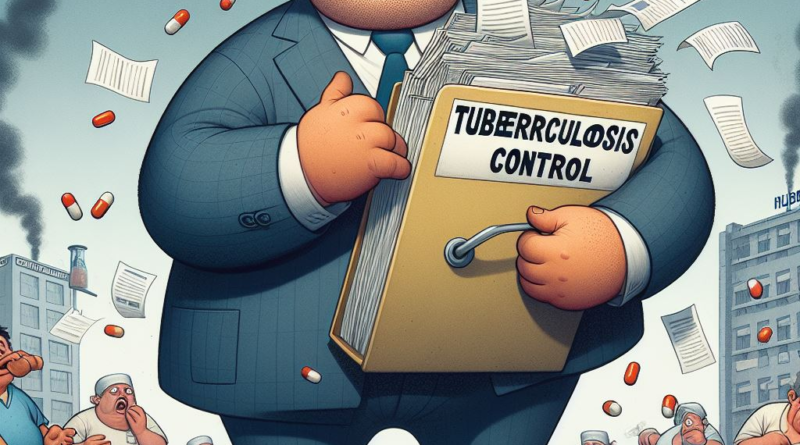Gross Mismanagement in Tuberculosis Control | Ias Banenge
Context:
A circular dated March 18, 2024, issued by the Health Ministry to all States, acknowledges that the supply of certain drug-sensitive medicines of Tuberculosis may face delays due to unforeseen and external circumstances. While States have been instructed to procure drugs locally for a three-month period, the circular also provides an option for States to reimburse the costs of medicines procured by patients if district health facilities fail to provide them free of charge.
Relevance:
GS2-
- Health
- Government Policies and Interventions
Mains Question:
Is India falling behind in efforts to control tuberculosis? What are the challenges in elimination of Tuberculosis from India? How successful have government initiatives been in this regard? (15 Marks, 250 Words).
READ MORE- On Climate Change as a Fundamental Right
About Tuberculosis:
- Tuberculosis, caused by the bacterium Mycobacterium tuberculosis, is an infectious disease that can affect virtually any organ in the body. Predominantly, it targets the lungs, pleura (the lining around the lungs), lymph nodes, intestines, spine, and brain.
- Transmission of tuberculosis occurs through airborne particles, primarily in close contact settings, especially in areas with high population density and inadequate ventilation.
- Common symptoms of active lung tuberculosis include persistent cough with sputum, occasional blood in the sputum, chest pains, weakness, weight loss, fever, and night sweats.
Types of Tuberculosis:
Pulmonary Tuberculosis:
- Pulmonary TB is characterized by its effect on the lungs, making it the most contagious type of TB. However, transmission typically occurs only after prolonged exposure to an individual with the illness.
- In most cases, the body’s immune system effectively eliminates the bacteria without causing any symptoms in healthy individuals.
Latent Tuberculosis:
- Latent TB occurs when the immune system is unable to eradicate the bacteria but successfully prevents its spread throughout the body.
- While individuals with latent TB do not exhibit any symptoms, the bacteria persist within the body. Importantly, individuals with latent TB are not contagious to others.
Active Tuberculosis:
- Active TB occurs when the immune system fails to either kill or contain the infection, allowing the bacteria to proliferate within the lungs or other organs, leading to the development of symptoms within a few weeks or months. This form of TB is contagious.
- Despite approximately one-quarter of the global population being estimated to carry TB bacteria, only 5-15% of those infected will develop active TB disease.
- It’s crucial to note that latent TB has the potential to progress into active TB disease, particularly if the individual’s immune system becomes compromised at a later stage.

Scarcity of Crucial Drugs:
- With less than two years remaining to achieve the ambitious goal set by the Prime Minister in 2018 to eradicate TB in India, the pharmaceutical sector of the Global South finds itself once again grappling with the treatment of patients afflicted with drug-sensitive TB.
- Alarmingly, India is currently facing a shortage of TB medication, a problem that seems to be escalating in frequency.
- Merely seven months ago, there was a severe scarcity of crucial MDR-TB drugs; disruptions in drug supply, which initially affected drug-sensitive medications in 2022, subsequently extended to encompass MDR-TB drugs, persisting for nearly a year.
- Likewise, in September 2021, India confronted a depletion in the stock of the MDR-TB drug Delamanid. The delay in diagnosing and initiating treatment is already a significant concern in the TB care continuum.
- Another concerning aspect is the number of patients who commence therapy but do not achieve successful treatment outcomes. However, tackling this issue, assuming the availability of drugs, will become increasingly challenging if instances of drug shortages become recurrent.
- A study conducted in 2010 revealed that the unavailability of drugs accounted for 8% of non-adherent patients missing their treatment regimen. Ensuring the consistent availability of medicines for various categories of TB patients across India should be an unquestionable priority.
- The fact that 14 years have passed since then, and with the target date of 2025 drawing near, there still exists a shortage of drug-sensitive TB medicines, which are exclusively manufactured in India by multiple entities, only serves to underscore the inadequate management of the national TB program.
Fundamental Issues remain Unaddressed:
- Renaming the National TB Control Programme to align with the Prime Minister’s goal as the National TB Elimination Programme, without addressing fundamental issues such as drug availability, reflects a profound incompetence and a lack of seriousness in combating TB effectively.
- Compounding this issue is the decision by the Health Ministry to authorize States to procure drugs locally at the eleventh hour, resulting in significant challenges at the grassroots level.
- The last-minute approval granted to States for local procurement is highly criticized. Furthermore, shifting the burden of purchasing medicines onto patients, even as a last resort, is deplorable, especially considering the predominantly low socioeconomic background of TB patients in India.
- Rather than making strides toward achieving the 2025 goal, India appears to be struggling with the most fundamental aspects of TB control.
Way Forward:
- The development and widespread adoption of an adult TB vaccine aim to reduce production costs, ensuring greater availability of anti-TB drugs for all individuals.
- Additionally, efforts are underway to innovate injection-free and oral pill formulations for TB treatment, enhancing accessibility and ease of administration.
- The utilization of AI-assisted handheld radiology, offering rapid and highly accurate TB diagnosis within 90 seconds with a 95% accuracy rate, represents a significant advancement in TB detection methods.
- To achieve the ambitious goal of eliminating TB by 2025, India must prioritize sustainability through strategic investments, targeting areas with the greatest need and adequately resourcing TB initiatives.
- Collaborative efforts and unwavering commitment are essential for India to overcome its TB burden and reach its target.
- Emphasis should be placed on understanding key determinants such as poverty, malnutrition, and tobacco use, with prevention being prioritized over cure.
- Furthermore, addressing gaps in the public healthcare system is imperative, as this is the primary avenue through which millions of Indians seek medical treatment.
Conclusion:
Despite the efforts of the Revised National Tuberculosis Control Program to improve patient diagnosis, provide free tests and medications, extend adherence support, and engage private healthcare providers, there is still room for improvement. Continued efforts and innovation are needed to further enhance TB control measures and ultimately eliminate the disease burden in India.





Pingback: Coordinated Lunar Time | Ias Banenge